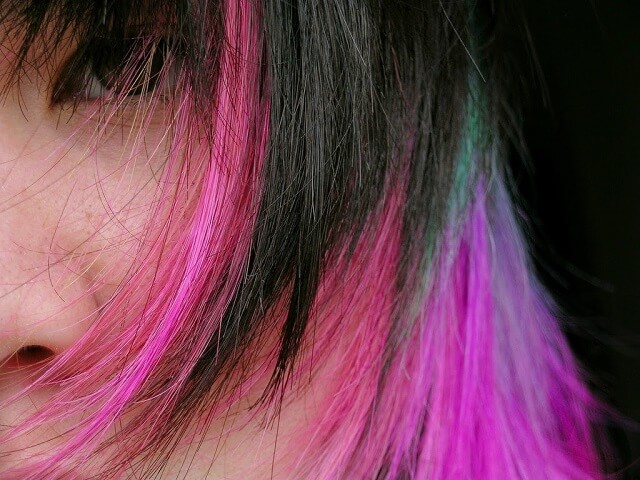
|
| [1] |
What is hair damage?
Hair bleach works through a chemical process called oxidation, which reacts with the natural melanin pigment in your hair to lighten it. Without this oxidation, neither bleach or permanent hair dye would be able to work.
The reaction isn't entirely beneficial to your hair however. Although oxidation allows hair to be lightened and dyed, it also compromises the protein in your hair. This protein is called keratin and when it is damaged by the chemical reaction, breakage becomes more likely.
Damaged hair loses its elasticity, colour retention, shine, and even affects its appearance and physical texture. Not only is your hair fragile after sustaining damage, but it can also become frizzy, unruly, prone to split ends, and overly dry. To maintain hair that is beautiful and feels soft, you need to repair bleached hair when it gets to this point.

|
| [2] |
How does hair repair work?
Hair repair products can be divided into two different types of product, both of which address damage in a slightly different way:
- Conditioning treatments
- Protein treatments
Whilst a conditioning treatment can make your hair soft and shiny, as well as help prevent future breakages and split ends, it's not the best treatment for pre-existing damage. Rather, it's a way to treat the symptoms of damage and help reduce and prevent further damage.
Protein treatments, however, are designed to restore the integrity of the protein in your hair. As keratin is a natural protein, it is possible to correct damage using treatments that fill in and replace the denatured protein to repair bleached hair to close to its former condition.
These kinds of treatments won't leave your hair soft and hydrated because they don't usually condition your hair. What they will do, however, is repair the structural damage. This is the root cause of most symptoms of damaged hair, and protein treatments are the best way to tackle the problem.
Using protein treatments to repair bleached hair

|
| [3] |
On top of this, any further bleaching, dyeing, or heat styling could completely destroy the hair if it's left in its current condition. Luckily, protein treatments are very cost effective as products like Redken Cat are highly effective and will last for a few months before you run out of the product and need to buy more.
The proper way to use a protein treatment will vary depending on the form the product takes. Some treatments are a cream, like Joico K-Pak Reconstructor, whilst others are often in spray form, like Redken Cat. Regardless of product form however, a protein treatment should always be applied after shampooing, because this is when your hair is clean and the cuticles are open, allowing optimal penetration.
Once applied, the treatment must be left for 5 minutes in most cases, but this can also depend on the brand. Some brands can contain an added deep conditioner to allow for comprehensive treatment. Joico K-Pak Reconstructor moisturises the hair whilst it restores the protein, allowing it to be left in for longer. Redken Cat, and similar products, shouldn't be left for longer than 5 minutes because the amino acids, protein, and fortifying ingredients in the product don't offer any further benefit once they have fully absorbed into your hair. The product needs to be reapplied a second time if more protein is needed.
Initially, protein treatments should be used up to 3 times a week after shampooing to repair bleached hair. If your hair is very damaged, you can increase this to every shampoo as necessary for a short time frame. After 1 - 2 weeks, this can be cut back to once or twice a week, and then gradually you will find that your hair is strong enough that you don't have to use the treatment anymore.
At this point, it's still good to use the product every few weeks to maintain strength and help keep your hair strong, especially if you use heat styling tools or intend to dye it again. Doing this is one of the best ways to maintain beautiful hair.

|
| [4] |
Intensive treatment plan
If you want to repair bleached hair and keep it looking and feeling its best, a protein treatment alone will produce great results, but it won't be enough to treat dryness, frizz, or the other problems you may be facing. Protein reduces these problems, but if your hair is very damaged or very dry, an intensive treatment plan is required.

|
| [5] |
- Apply protein products as above. Start by applying the product 1 - 3 times a week, gradually cutting back to once a week.
- Follow this with a deep conditioning treatment like Redken Butter Treat or Schwarzkopf Bonacure in place of your regular conditioner. These treatments relieve dryness and help prevent frizz much more effectively than plain conditioner.
- After getting out of the shower and towel-drying your hair, apply a leave-in moisturiser.
- Dry your hair as usual, either naturally or with a blow dryer.
- Apply a smoothing serum like Redken All Soft or Macadamia Oil to lock in moisture and protect from humidity, then style your hair as usual. Serums protect your hair from heat, so you can use curling or straightening irons without worry. Better still, they reduce frizz and smooth the hair; especially when followed up with a heat styling tool.
- If you used a heated styling tool in the previous step, apply another small dab of smoothing serum to your hair to boost shine and seal moisture in. If you didn't use a heat tool, this last step isn't required.
After a few weeks, you can ease off the treatment plan and your hair will remain strong and healthy. Continuing to use a smoothing serum is recommended as they are excellent products and really do help your hair retain moisture and look its best.
More information:
- Repairing hair breakage - Find out how to snap your hair snapping and restore its former strength...
- Choosing a shampoo - There are many different shampoos available. Discover how to select the right one for your hair type...
- Blonde hair care and maintenance - Find out how to care for hair that has been dyed blonde...
Do you need help with damaged hair? Want a treatment plan that's geared towards the product lines you prefer to use? Leave a comment for more information about how to repair damaged hair and keep your hair looking great.
Had dark hair which was colored dark from highlights a year ago....went blonde but it only pulled yellow blonde...to do that she did color removal process 2 times...then bleach creme all over...then highlight and base color....then again she highlighted the darker base color with bleach....then finally applied another base and highlight....so EXTREME bleach...hair feels like spongy knots and EXTREMELY dry....i put oil immediately the next day for 24 hours...and then did #3 Olaplex treatment...washed and styled with blow dryer and straigjtener. It feels soo rough and damaged. Need help. During this prcproc she did 2 Olaplex treatments and as an additive as well. I had Keritan treatment before but didnt like it as it made it seemed more damaged. What is best natural way or best way without chemicals to get protein...meaning without the heat method? Eggs?
ReplyDeleteHi,
DeleteIf you use a protein treatment like Redken Cat, that doesn't involve heat. Keratin treatments do involve heat to set the keratin protein into your hair, so they're a more extreme kind of treatment, and they also affect the hair slightly differently because of the keratin. Regular protein treatments contain a little keratin but it's not set into the hair and it's less concentrated because other forms of protein and strengthening ingredients are more prominent in these products, so you may find these work better for you.
For a more natural way though, egg whites are the easiest way. They're high in protein, as well as a few vitamins and minerals that can also help. The effect won't be as powerful as a protein or keratin treatment, but it can work. Other more natural methods would be to mix up something like whey protein in water and apply, or empty out amino acid capsules into shampoo.
Just make sure whatever you do use, that you rinse it out thoroughly, and use somewhat cool water; especially when using eggs. Heat makes protein coagulate. This is beneficial in a keratin treatment, but leads to scrambled egg hair in the case of egg whites.
What about any oils ? Do you recommend any oils for treating porus, damaged hair?
ReplyDeleteHi Sally,
ReplyDeleteOil can protect hair that is already damaged, as well as prevent further damage by preventing dryness which would otherwise leave damaged hair brittle and more prone to breakage. It doesn't have much of an effect on damage past this function though. Protein repairs damage because the damaged protein in your hair is treated directly, and other products like ceramide can help patch weak areas, so these are more of a targeted treatment.
Basically, use conditioners, oils, and serums to keep your hair soft and nourished and protect it from further damage and the breakage that can occur through existing damage. To repair the hair to any great degree though, it's best to treat using protein.
Almost every other bleached hair related site says coconut oil is the Best thing since sliced bread for bleached hair. Hair masks are mentioned too, this is the first I'm hearing about protein. So our dead grown damaged hair can really absorb protein? I'm in the medical field and have a hard time believing that. I did hear it years ago from a Redden specialist but never could accept it. It hair is soft and shiny it looks healthy.
ReplyDeleteHi Shipshaped,
DeleteThe strength of your hair is due to disulfide bonds, formed through the interaction of cystine molecules within the protein of your hair. It is the cystine within your hair that is damaged by oxidation, resulting in broken bonds and reduced strength.
Protein sources used in hair care form covalent bonds with damaged cystine to restore the bonds, and thus restore strength and structure.